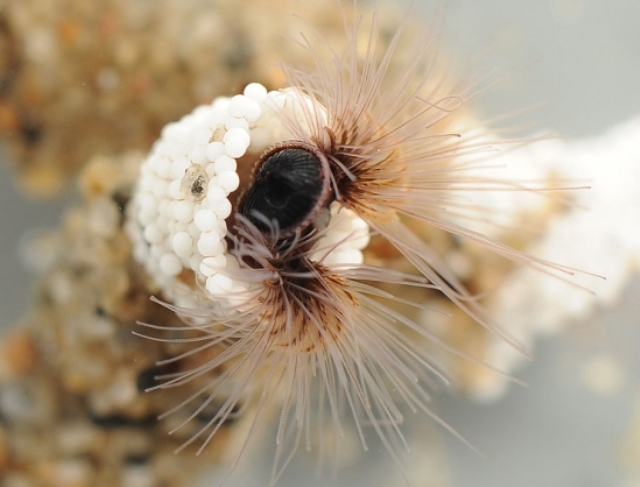Feb 4 2016
A new underwater adhesive substance has been developed by UC Santa Barbara’s interdisciplinary group of researchers. This adhesive can be used for a variety of non-biological and biomedical applications. Areas that could benefit from this glue, include dental adhesion, tissue repair and other surface adhesion applications which are usually done under adverse conditions like in aqueous solutions with organic impurities and salty sea water.
 Sandcastle worm (Phragmatopoma californica) Photo Credit: Fred Hayes
Sandcastle worm (Phragmatopoma californica) Photo Credit: Fred Hayes
The glue mimics the Sandcastle worm’s (Phragmatopoma californica) bonding techniques. This worm is a segmented marine invertebrate, which can be found in and along California’s coastlines.
Like mussels and other glue-secreting inhabitants that live in the littoral zones, the sandcastle worm builds a hive-like shelter of colonies out of sand grains, glued together with a self produced protein adhesive. This phenomenon serves as an inspiration for engineers and scientists trying to synthesize a similar adhesive substance, which works in damp, submerged and otherwise hostile circumstances.
Sandcastle worms secrete a robust underwater adhesive to build a tube reef (sandcastle) in harsh intertidal environments, where wind and wave velocity often exceed 25 meters per second. We successfully replicated the strong wet-contact adhesion of the bio-adhesion featuring nanoscopic chemical and microscopic porous structures.
Kollbe Ahn, Research Faculty Member, UCSB’s Marine Science Institute
Though synthesized wet glues have been the subject matter of research and development for many years, they are still yet to match the performance of their natural counterpart, in terms of stickiness and the rapidity of the adhesion process. This synthetic underwater adhesive requires complex processing, which adds several steps to the procedure and makes it more complex than it would ideally be.
From practical perspectives, simple processing saves time and labor, and ultimately reduces costs.
Qiang Zhao, Materials Scientist, UCSB
He explains that the sandcastle worm-inspired glue provides more streamlined adhesion through the solvent exchange process, and this strategy makes it unique and remarkable.
The processing of this wet glue does not need pre-immersive dry curing or applied compressing pressure that are normally required in conventional studies.
Qiang Zhao, Materials Scientist, UCSB
The glue also helps in bonding various surfaces including wood, plastics, glasses, metal and biological tissues.
The resulting microarchitecture of the artificial glue is more resistant to cracking, as it mimics the sandcastle worm adhesive’s porous structure.
Porous structures, or cellular structures, are ubiquitous in nature, such as in cork, bones and coral, and they are found to increase fracture energy of these materials. Here in the context of wet adhesion, we found that the porosity was reminiscent of the porous structures of sandcastle worm cement, and significantly improved wet adhesion.
Qiang Zhao, Materials Scientist, UCSB
This development is UCSB’s latest effort to create an adhesive solution that works in damp, wet and complex conditions, which can lead to various applications; including the mending of bones, tissues, skin and membranes surrounded by bodily fluids, and dental adhesion. This technology will also benefit commercial and industrial applications, which require adhesion in wet environments. Through the observations and studies of intertidal zone creatures (like mussels and sandcastle worms), researchers anticipate to develop a more eco-friendly adhesion process by producing and optimizing a glue that bonds at rapid speeds, works under different conditions, and avoids the use of organic solvents.
Dong Woog Lee, Sungbaek Seo, Yair Kaufman, Jacob Israelachvili and J. Herbert Waite, all at UCSB have also contributed to the study.